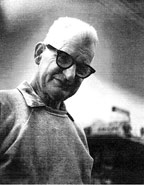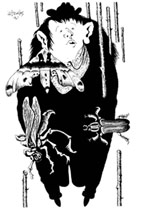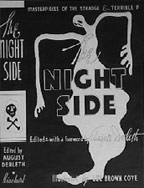Lee Brown Coye was born in Syracuse, New York, and as a young man lived in nearby Tully. He spent his entire life in the Central New York area. He and his wife, Ruth, lived in Syracuse for many years where Coye's activities included teaching adult art classes; working under the Works Progress Administration to paint a mural in the Cazenovia High School in 1934 (since destroyed); advertising for the WSYR Broadcasting System; producing a variety of commissioned works; and pursuing his own interests as an artist. The Coyes settled in Hamilton, New York, in 1959 when Lee went to work for Sculptura, a small company that reproduced antique sculptures. The move to Hamilton allowed Coye to fulfill his ambition of returning to a small town and maintaining his own art studio.
Coye was a self-taught artist whose entire life was devoted to art-related work. As a young man, he attended one semester of night art classes, but his artistic knowledge and abilities came from many years of work and a thorough study of nature. His astute knowledge of the human body developed from his studies of anatomy and his work as a medical illustrator. He attended operations and autopsies and thus became extremely familiar with the human body assembled or not.
One recurring feature in Coye's work is the motif of wooden sticks. In 1938, Coye returned to the North Pitcher, New York, area where he spent much of his childhood. It was there, deep in the woods, that Coye first came into contact with these sticks. His walk led him to an abandoned farmhouse. Boards and pieces of wood which had been set perpendicular to one another surrounded the site. Neither inside nor out could Coye find an explanation for the presence of these crossed sticks. In the years following, Coye remained interested in the significance of his discovery, but when he returned to the site in 1963, there was nothing left of the building or the sticks, and he never found out why the sticks were there or who it was that had arranged them in such a manner. Because of the strangeness of the entire experience, these forms never left Coye, and they appear in many of his paintings and illustrations.
The crescent moon was an early Coye trademark in paintings and illustrations. The whale became a later signature motif. Coye fashioned wooden sculptures, silver pendants and pins, engravings, drawings, and a large painting of the whale.
One very fine example in the SUNY Morrisville Library collection is the three-foot long, pine "Moby Dick" sculpture created in 1965.
Coye's fame as an illustrator of the macabre developed as a result of his drawings for Weird Tales, a popular pulp magazine. From 1945 to 1952, his covers and illustrations captured images of horror and the supernatural. In the 1960s, Coye's work appeared in such magazines as Fantastic and Amazing. Coye illustrated August Derleth's horror story anthologies, Sleep No More, Who Knocks, and The Night Side, as well as the H. P. Lovecraft collection, 3 Tales of Horror, and Manly Wade Wellman's anthology, Worse Things Waiting. In 1975 and again in 1976, Coye won the World Fantasy Award for best artist.
Although Lee Brown Coye is best known for his fantasy and horror illustrations, for more than 50 years, his artistic output covered a much wider range. He was a watercolor, oil, and egg tempera painter, a muralist, a sculptor, a photographer, a silversmith, and an able builder of models and dioramas. From rats, beetles and disfigured bodies, to whales, mythic figures, and landscapes, Coye's subjects are as diverse as the media in which he worked. All of his work was executed with expert craftsmanship and exhibits the originality that sprang from his imagination and sense of humor. Coye created paintings, sculpture, and jewelry that are as beautiful as his illustrations are macabre.
Coye's work is represented in numerous collections including the Metropolitan Museum of Art in New York, the Everson Museum in Syracuse, the Onondaga County Historical Society, Colgate University, the SUNY Morrisville Library, SUNY Oswego, Syracuse University, and private collections.
Based on an article by Tammra Rayfield, "Lee Brown Coye: Illustrator and Artist, in The Mage, Summer 1985," with additional material supplied by Robert Coye.




